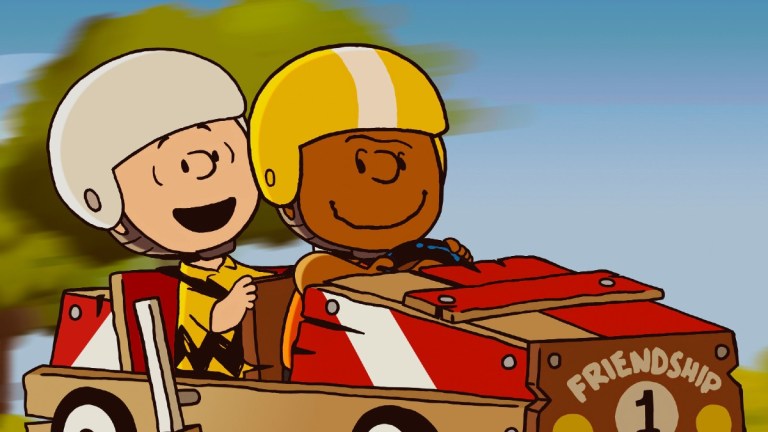Peanuts’ Franklin Special Is Worth the 50-Year Wait
Franklin Armstrong finally gets a seat at the table in an Apple TV+ special that celebrates Peanuts history.

At long last, Franklin Armstrong has gotten the spotlight. After 55 years, the first Black character inducted into the Peanuts gang gets to show off his complexities beyond his complexion in Apple TV+‘s latest Peanuts special, Snoopy Presents: Welcome Home Franklin. Right in time for Black History Month, no less.
The special focuses on the titular character depicted as a socially awkward kid who struggles to make new friends organically in the new neighborhood his family moves into. When he befriends hapless Charlie Brown, they instantly bond and enter a soapbox derby race. Franklin was never given this much attention or personality despite his long-running presence in Peanuts. As overdue as this special was, the significance of Franklin as a character cannot be overstated -not only to the Peanuts series but also to the diversity across the comic medium and the voices it inspired. One of whom was a co-writer on the special.
In 1968, shortly after the assassination of Martin Luther King Jr., then LA-based schoolteacher Harriet Glickman wanted to change the state of rampant racism throughout the nation and thought comic strips were the best medium to permeate change. So she mailed many cartoonists, including Peanuts creator Charles M. Schulz, and requested them to integrate a Black character into their comics.
Schulz replied, “We all would like very much to be able to do this, but each of us is afraid that it would look like we were patronizing our Negro friends. I don’t know what the solution is.” He asked Glickman if any of her friends could advise him on how to write a Black character. Her African-American friend, Ken Kelly, instructed Schulz: “Just make the character a regular kid.” Thus, on July 31, 1968, Schulz introduced the world to Franklin.
His first appearance started with Charlie Brown at the beach looking for a beach ball and Franklin returning it to him. The two start chatting about their backgrounds, with Franklin revealing how his father currently serves in the Vietnam War and Charlie Brown discussing how his dad’s a barber who also served in a war but can’t recall which one.
Welcome Home Franklin stays faithful to Franklin’s comic roots with the boys meeting at the beach, but this time from Franklin’s perspective. Through the soapbox derby arc, which furthers Charlie Brown and Franklin’s friendship, he shares his interests and family history with his favorite musicians, James Brown, Stevie Wonder, and John Coltrane (taste, my brother!) and his family lineage ties back to the Negro Leagues.
After Schulz integrated Franklin into his team, he maintained a down-to-earth and neutral demeanor instead of the distinctive ensemble because he didn’t want to stir any controversy. In a 1988 interview with Michael Barrier, Schulz acknowledged, “But I’ve never done much with Franklin because I don’t do race things. I’m not an expert on race. I don’t know what it’s like to grow up as a little black boy, and I don’t think you should draw things unless you really understand them, unless you’re just out to stir things up or to try to teach people different things.”
He also shared how the most significant backlash he received from Franklin came from newspaper editors, particularly in the American South, for they didn’t like to see Franklin playing with the other children. Schulz recalled how an editor complained over Franklin sitting in the same row of school desks with Peppermint Patty and said, “We have enough trouble here in the South without you showing the kids together in school.”
Larry Rutman, the then-president of United Feature Syndicate, and Schulz had a call over Franklin and asked if he could change it. After hours on the phone, Schulz pulled the greatest flex of an ultimatum, saying, “Well, Larry, let’s put it this way: Either you print it just the way I draw it, or I quit. How’s that?” King Schulz Only!
Throughout the years, Franklin made his way to the screen, appearing in many Peanuts specials and movies, starting with the feature film Snoopy Come Home (well, it was silent then) but then had a speaking one in There’s No Time for Love, Charlie Brown. One of his most infamous appearances was A Charlie’s Brown Thanksgiving, where he was animated to sit alone on the opposite side of Charlie Brown, Peppermint Patty, Linus, Sally, and Marcie. I don’t assume that Franklin’s lone spot was intentional, considering that his inception challenged segregation. And that’s where Welcome Home Franklin rights that wrong by having Linus invite him to sit amongst him and his pals at a pizza parlor, updating the infamous shot that stirred controversy for fifty years.
Because Franklin was an essential part of the Peanuts gang, many Black artists were inspired by his inclusion for representation, which was so minimal at the time. One in particular was Robb Armstrong, creator of Jump Start, one of the first strips by a Black man about a Black family. Armstrong knew at age three what career he wanted to pursue, saying, “I want to be in the papers just like Snoopy.” Jump Start got picked up in 1989 by Peanuts’ same distributor, United Feature Syndicate and Armstrong got to befriend Schulz, who was a major inspiration for him, a la Peter B. Parker with Miles Morales.
Soon after, Schulz called Armstrong and asked him if Franklin could have his last name, and he said yes. Then, during the ‘90s special “You’re in the Super Bowl, Charlie Brown,” it was revealed that Franklin’s full name was Franklin Armstrong. In an interview with Star Tribune, Robb Armstrong shared, “I didn’t think about it at the time. But when Franklin turned 50, I did an interview about it, and it made me realize what an honor it was.”
Cut to today, where Robb Armstrong is a co-writer on the special, adding authenticity to the character’s namesake and making his late friend and mentor proud. Throughout the 50 years, Franklin’s typical kid innocence left a lot of personality to be desired. For so long, he was relegated to being the hip kid who knew how to break dance or play every sport. In Welcome Home Franklin, Armstrong and his fellow writers Bryan Schulz, Craig Schulz, and Cornelius Uliano ambitiously flesh out the character to have him uniquely fit in with the rest of the gang. They elaborate on his flaws, where he’s awkward, impulsive, and independent to the degree it’s hard for him to trust others. His traits tie into his upbringing within a military family that moved around a lot, so it adds dimension to him in ways we’ve all been waiting for.
With Franklin’s reintroduced fit for the inclusive landscape of this generation, longtime Peanuts fans, especially Black ones like myself, can sit up and watch the special with their kids and rejoice in seeing how far Franklin has come to have his moment and sit amongst his pals at the table.
Snoopy Presents: Welcome Home, Franklin premieres globally Friday, Feb. 16 on Apple TV+.
